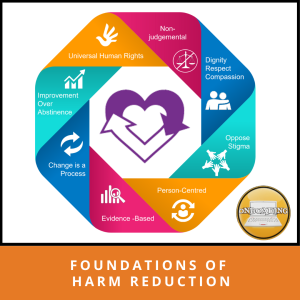Foundations of Harm Reduction: Onboarding NEW

Available Summer ’24
Logistics
Type: Self-Paced / Onboarding
Time to Complete: 90 minutes
Target Audience: This module is appropriate for anyone working in the homeless sector, specifically outreach workers, case managers, and others having direct contact with people experiencing homelessness. It is also beneficial for organization, program, and system leadership.
Components
- Videos
- Text
- Exercises
- Knowledge Checks
- Final Assessment
- Course Evaluation
- Completion Certificate
Description
A Government of Canada study looking at coroner and medical examiner data from 2016 and 2017 capturing information on substance-related toxicity deaths (overdose). They found that people experiencing homelessness are “over-represented” among those who died of overdose and the majority of those deaths were accidental. People experiencing homelessness have higher rates of substance use than the general population. The relationship between housing insecurity and substance use is complex. Substance use is both a reason for housing loss and a way of dealing with the difficulties and dangers of life without a secure home. People experiencing homelessness have added pressure to conceal or rush substance use, use alone, and use larger amounts to avoid drug possession charges. These substance use patterns are more dangerous and can lead to higher rates of acute toxicity events. This means that those supporting people experiencing homelessness in any way, should have some level of knowledge and skill to help prevent these deaths and assist people along a path of self-determined recovery.
Harm reduction incorporates a spectrum of evidence-based and evidence-informed strategies from safer use, to managed use, to abstinence to meet drug users “where they’re at” and addressing conditions of use along with the use itself. In this module, you will learn the benefits of harm reduction and how harm reduction strategies can be applied to reduce harm and further complications from drug use and reduce the harm and risks to the community. The course will dispel some common myths of harm reduction and illustrate where it fits within the continuum of substance use (SUD) treatment and recovery. Participants will gain and understanding of harm reduction principles and services and be able to define what it means to “practice” harm reduction.
Learning Objectives
- Define harm reduction as it is used in engaging people who use substances into services and support.
- Identify benefits of harm reduction for the individual and/or community.
- Discuss the history of harm reduction and where it fits today in the continuum of care and support in the homelessness sector.
- Identify the principles and philosophy of harm reduction and examples of tools and services.
- Recognize an effective harm reduction practice in contrast to a practice that does not apply harm reduction principles.
